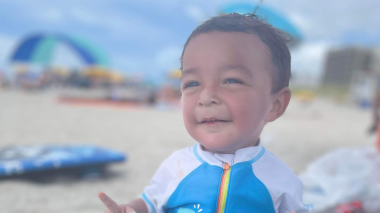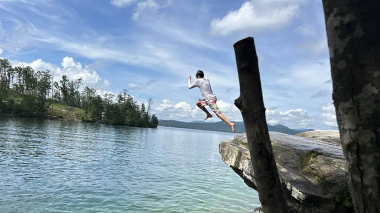We all know the symptoms and treatment for sicknesses like the common cold. But have you heard of respiratory syncytial virus (RSV)? RSV is a very common virus that infects the respiratory tract of most infants and children before they’re two years old. Amina Ahmed, MD, with Atrium Health Levine Children’s Infectious Disease shares some of her answers for the top questions parents ask about RSV.
Question 1: Is RSV just a bad cold? If not, what are the main differences between the two?
Answer 1 | Dr. Ahmed: In children and infants, RSV is more than a bad cold. The virus infects the upper respiratory tract (nose, throat) as well as the lower respiratory tract (bronchioles, which are the tubes that carry oxygen to the lungs).
All children have typically had the virus by the time they are 2 years of age, but they can get it multiple times, with each illness being milder than the previous one.
For very young infants (< 6 months), when the virus infects the lower respiratory tract, it causes inflammation and swelling, which means oxygen delivery is compromised. As children get older, they get immunity from previous infections and their airways are bigger, so they are less likely to experience severe symptoms – thus the infection becomes a “bad cold.”
Q2: Why can RSV be more dangerous for babies under 6 months?
A2 | Dr. Ahmed: Similar to what had been mentioned above, the virus is more dangerous because immunity from repeat infections has not built up and because the airways of babies are narrower.
The first time an infant has the infection, they have no immunity so the child cannot fight or get rid of the infection as quickly as an older child who has been infected several times and built up immunity.
Additionally, the virus likes to infect the bronchioles (airways), and these are much narrower in younger infants than in older children. So, the inflammation and swelling can cause these bronchioles to swell to the point of closing off. This results in difficulty breathing and need for oxygen, which can lead to hospitalization. All children have had at least one infection due to RSV by the time they are two years old, and the younger the child at the time of the first infection, the more severe the infection and the clinical picture.
Q3: What are the RSV symptoms that parents should be on the lookout for in infants under 6 months?
A3 | Dr. Ahmed: The typical symptoms are:
- Fever
- Nasal congestion or rhinorrhea (runny nose)
- Cough and difficulty breathing (respiratory distress)
Due to nasal congestion and difficulty breathing, the infant is unable to feed properly and thus there is also poor feeding which can lead to dehydration. The virus infects the mucus of the nose, throat, trachea (tube leading to airways), bronchioles and lungs.
The infection also can cause inflammation and swelling, as well as “shedding” of the lining of the mucus. This causes the cough. The swelling of the bronchiole compromises oxygen delivery, which means the infant breathes faster to get more oxygen and, when the infant can’t keep up, requires oxygen supplementation.
Q4: How can you protect your baby from RSV? Is there a vaccine for it?
A4 | Dr. Ahmed: While there is not a vaccine available for RSV yet, there is an antibody product that provides protection (Synagis) that is indicated for those at highest risk:
- Very premature infants in their first 6 months of life during RSV season
- Infants with congenital heart disease
- Infants who have chronic lung disease that requires oxygen or other significant support
This product must be given monthly during RSV season (November-March) with the goal of preventing hospitalization. Scientists continue to work vigilantly on a vaccine.
The best way to protect your baby is to make sure anyone handling the baby washes their hands well so they cannot transmit the infection. Also, do not allow others to kiss the baby on the mouth or the hands.
Q5: What are some RSV symptoms that should never be ignored? What should parents do if they notice any of these symptoms in their children? What do they mean?
A5 | Dr. Ahmed: Rapid breathing is a sign that the child is not getting enough oxygen. Typically, the fever and nasal congestion start first. Illness peaks on day 4-5 and at that point it is important to look for rapid breathing. Another important symptom is poor feeding, even if it is due to nasal congestion, because that can lead to dehydration.
Q6: How is RSV different in toddlers and older babies?
A6 | Dr. Ahmed: Just because a child has had the infection it does not prevent future infections completely. However, there is some immunity so subsequent infections are milder.
So, the older the child, the milder the infection with each subsequent infection. Additionally, older babies have larger airways than younger airways, which means the inflammation is less likely to cause total obstruction of the airways. That is why the young infants (< 6 months) tend to be the ones who are hospitalized whereas the older ones may have more of a “bad cold.”
Q7: What is the best treatment for RSV?
A7 | Dr. Ahmed: The treatment is “supportive” meaning providing oxygen (if needed), suctioning the nose, making sure the baby is well hydrated, and fever control. We occasionally try medicine like albuterol which opens airways, but it does not work for all babies. The best intervention has been suctioning the infant.



